 W
WThis is a list of notable seafood dishes. Seafood dishes are food dishes which use seafood as primary ingredients, and are ready to be served or eaten with any needed preparation or cooking completed. Many fish or seafood dishes have a specific names ("cioppino"), while others are simply described or named for particular places. Bisques are prepared with a variety of seafoods.
 W
WAfritada is a Spanish based Filipino dish consisting of chicken, beef, or pork braised in tomato sauce with carrots, potatoes, and red and green bell peppers. It is served on white rice and is a common everyday Filipino meal. It can also be used to cook seafood.
 W
WAsopao is a family of stews originating in Puerto Rico. Asopao can be made with chicken, pork, beef, shrimp seafood, vegetables, or any combination of the above. Asopao is Puerto Rico's national soup and one of the most important gastronomic recipes in Puerto Rico.
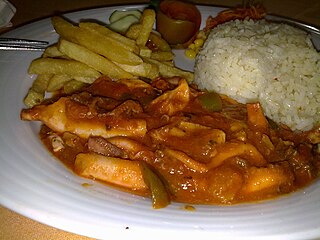 W
WBafa it a traditional dish of the Capeverdean cuisine.
 W
WBalchão has been described as "a fiery dish from Goa which is almost like a pickle". It is a spicy seafood or meat dish in Goan cuisine.
 W
WBánh canh is a thick Vietnamese noodle that can be made from tapioca flour or a mixture of rice and tapioca flour. "Cake" refers to the thick sheet of uncooked dough from which the noodles are cut.Bánh canh cua – a rich, thick crab soup, often with the addition of quail eggs. Bánh canh bột lọc – a more translucent and chewy version of the noodle. Bánh canh chả cá – the dish includes fish cake and is popular in the South Central, Vietnam. Bánh canh giò heo tôm thịt – includes pork knuckle and shrimp. Bánh canh Trảng Bàng – bánh canh made in the southeastern Vietnamese town of Trảng Bàng, served with boiled pork, tapioca noodles, and local herbs. Bánh canh tôm – a shrimp-flavoured broth that is also mixed with coconut milk.
 W
WBisque is a smooth, creamy, highly seasoned soup of French origin, classically based on a strained broth (coulis) of crustaceans. It can be made from lobster, langoustine, crab, shrimp, or crayfish. Alongside chowder, bisque is one of the most popular seafood soups.
 W
WBún mắm is a fermented thick Vietnamese vermicelli soup sometimes called "Vietnamese gumbo."
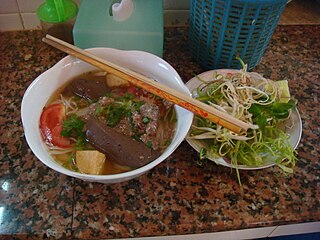 W
WBún riêu is a traditional Vietnamese soup of clear stock and rice vermicelli. There are several varieties of bún riêu, including bún riêu cua, bún riêu cá (fish) and bún riêu ốc (snail). This dish is well-known in the country and in the world.
 W
WCaguamanta is a typical Mexican seafood dish made with manta ray and shrimp. It is usually prepared as soup, containing manta ray, shrimp and vegetables. It also can be prepared as tacos. When the broth is served alone, it is called bichi taken from the Yaqui language word that means "naked."
 W
WA cataplana is an item of cookware used to prepare Portuguese seafood dishes, popular in the country's Algarve region. According to The Oxford Companion to Food, the most famous dish made in a cataplana is amêijoas na cataplana.
 W
WCaviar is a food consisting of salt-cured roe of the family Acipenseridae. Caviar is considered a delicacy and is eaten as a garnish or a spread. Traditionally, the term caviar refers only to roe from wild sturgeon in the Caspian Sea and Black Sea. Depending on the country, caviar may also be used to describe the roe of other species of sturgeon or other fish such as salmon, steelhead, trout, lumpfish, whitefish, or carp.
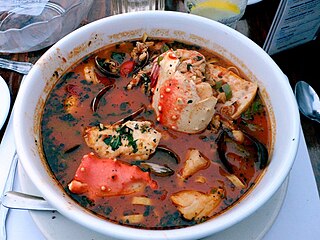 W
WCioppino is a fish stew originating in San Francisco, California. It is an Italian-American dish and is related to various regional fish soups and stews of Italian cuisine.
 W
WCrab sticks, krab sticks, imitation crab meat or seafood sticks are a type of seafood made of starch and finely pulverized white fish (surimi) that has been shaped and cured to resemble the leg meat of snow crab or Japanese spider crab. It is a product that uses fish meat to imitate shellfish meat.
 W
WCuranto is a traditional food of Chiloé Archipelago that has spread to the southern areas of Chile and Argentina, whose remains dated back about 11,525 ± 90 uncalibrated years before present. It consists of seafood, meat, potatoes and vegetables and is traditionally prepared in a hole, about a meter and a half deep, which is dug in the ground. The bottom is covered with stones, heated in a bonfire until red.
 W
WThe practice of eating live seafood, such as fish, crab, oysters, baby shrimp, or baby octopus, is widespread. Oysters are typically eaten live. The view that oysters are acceptable to eat, even by strict ethical criteria, has notably been propounded in the seminal 1975 text Animal Liberation, by philosopher Peter Singer. However, subsequent editions have reversed this position. Singer has stated that he has "gone back and forth on this over the years", and as of 2010 states that "while you could give them the benefit of the doubt, you could also say that unless some new evidence of a capacity for pain emerges, the doubt is so slight that there is no good reason for avoiding eating sustainably produced oysters".
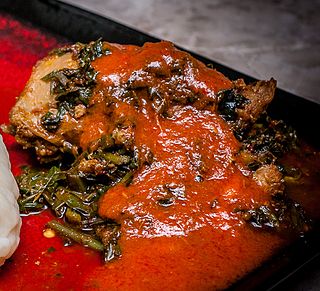 W
WẸ̀fọ́ riro is a spinach stew from Yorùbá cuisine prepared with vegetables and stockfish, palm oil, crayfish, pepper, locust bean and may also include meat and other ingredients.
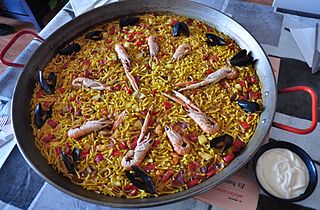 W
WFideuà is a seafood dish originally from the coast of Valencia that is similar to paella, and even more so to arròs a banda, but with noodles instead of rice. Its main ingredients are pasta noodles, fish, and shellfish. It is seasoned mainly with lemon.
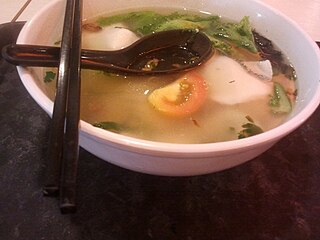 W
WFish soup bee hoon, also known as fish head bee hoon, is a Singaporean soup-based seafood dish served hot usually with bee hoon. The dish is viewed as a healthy food in Singapore. Catherine Ling of CNN listed fish soup bee hoon as one of the "40 Singapore foods we can't live without".
 W
WGolbaengi-muchim (골뱅이무침) or moon snail salad is a type of muchim (salad) made by mixing moon snails with vegetables. In South Korea, it is an anju typically made with red, spicy sauce and served with boiled somyeon. Like other anju, it is sold in pojangmacha. In North Korea, golbaengi-muchim is a white, non-spicy dish eaten as banchan.
 W
WGreek-style fish – a dish known in Poland possibly based on Greek Psari Plaki, served hot or cold which is prepared from fried pieces or fillets of fish in vegetable sauce. Basic sauce ingredients are grated carrots, parsley, celery, onion as well as tomato concentrate. All of them are fried in oil and then braised with water, salt, pepper and spices. After frying, fish is shortly braised with previously stewed vegetables.
 W
WGumbo is a soup popular in the U.S. state of Louisiana, and is the official state cuisine. Gumbo consists primarily of a strongly-flavored stock, meat or shellfish, a thickener, and the Cajun/Creole "holy trinity" ― celery, bell peppers, and onions. Gumbo is often categorized by the type of thickener used, whether okra or filé powder.
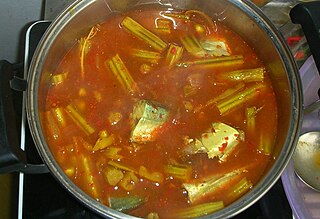 W
WKaeng som or gaeng som or Thai sour curry is a sour and spicy fish curry or soup with vegetables popular in southern Thailand. The curry is characteristic for its sour taste, which comes from tamarind (makham). The recipe uses palm sugar to sweeten the curry.
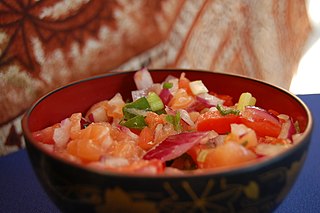 W
WLomi salmon is a side dish in Hawaiian cuisine. It is a fresh tomato and salmon salad, and was introduced to Hawaiians by early Western sailors. It is typically prepared by mixing salted, shredded salmon with tomatoes, sweet gentle Maui onions, and occasionally scallions, and sometimes crushed ice if it is not refrigerated. It is always served cold.
 W
WMaeun-tang (매운탕) or spicy fish stew is a hot spicy Korean cuisine fish soup boiled with gochujang, '고춧가루'(chili powder), and various vegetables. The name is a combination of two words: '매운', which derives from '맵다', meaning "hot and spicy"; and '탕(湯)', meaning "soup". As its main ingredient, fresh or saltwater fish is cut into several pieces and boiled with green vegetables such as watercress and garland chrysanthemum. Onion, radish, chilis, crown daisy, garlic, and sometimes zucchini and bean curd are added to the mixture to absorb the chili pepper paste which is the main flavoring of this dish. It is then seasoned with chili powder, garlic, soy sauce, and additional gochujang may be added once more to taste.
 W
WMoules-frites or moules et frites is a main dish of mussels and fries originating in Belgium. The title of the dish is French, moules meaning mussels and frites fries, with the Dutch name for the dish meaning the same. It is considered the national dish of Belgium.
 W
WNamasu (膾) is a Japanese dish consisting of thinly sliced uncooked (nama) vegetables and seafood, marinated in rice vinegar (su) for several hours, pickling them slightly. Namasu was brought to Japan from China during the Nara period (710-794).
 W
WOrange cuttlefish or orange squid is the most common English name used for the cuttlefish dish in Cantonese cuisine. It is a siu mei although it is not quite roasted. The dish is most commonly found in Southern China, Hong Kong and overseas Chinatowns.
 W
WOta ika is a Polynesian dish consisting of raw fish marinated in citrus juice and coconut milk. The Tongan, Tahitian, and Samoan variants are essentially identical in that the raw fish is briefly marinated in lemon or lime juice until the surface of the flesh becomes opaque. The fish is then mixed with coconut milk and diced vegetables. This is the national dish of Tonga.
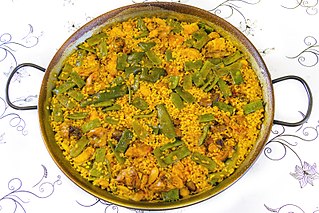 W
WPaella is a Spanish rice dish originally from Valencia.
 W
WPaila marina is a traditional Chilean seafood soup or light stew usually served in a paila. It usually contains a shellfish stock base cooked with different kinds of shellfish and fish. These are complemented with a variety of herbs and spices such as paprika and parsley.
 W
WA plateau de fruits de mer is a seafood dish of raw and cooked shellfish served cold on a platter, usually on a bed of ice.
 W
WPoke is diced raw fish served either as an appetizer or as a main course and is one of the main dishes of Native Hawaiian cuisine. Traditional forms are aku and heʻe (octopus). Heʻe (octopus) poke is usually called by its Japanese name tako poke, except in places like the island of Niʻihau where the Hawaiian language is spoken. Increasingly popular ahi poke is made with yellowfin tuna. Adaptations may feature raw salmon or various shellfish as a main ingredient served raw with the common poke seasonings.
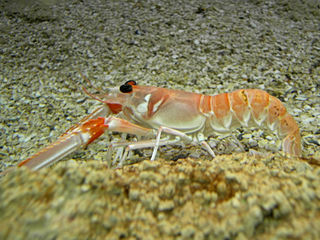 W
WScampi, also called Dublin Bay Prawn or Norway Lobster, is an edible lobster of the order Decapoda. It is widespread in the Mediterranean and northeastern Atlantic, from North Africa to Norway and Iceland, and is a gastronomic delicacy. Scampi is now the only surviving species in the genus Nephrops, after several other species were moved to the closely related genus Metanephrops.
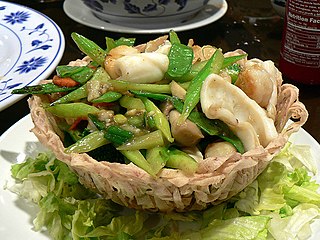 W
WSeafood birdsnest is a common Chinese cuisine dish found in Hong Kong, China and most overseas Chinatown restaurants. It is also found within Cantonese cuisine. It is usually classified as a mid to high-end dish depending on the seafood offered.
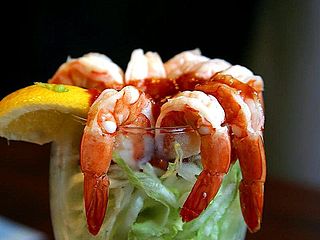 W
WSeafood cocktails are appetiser dishes including shrimp cocktail, squid cocktail, and mixed seafood cocktails. Various preparations use ingredients such as fish and octopus. Seafood cocktails often include lime juice, a tomato based sauce and are sometimes served with lemon. Seafood cocktails are eaten in the U.S. and Latin America. In the US, they are regulated by the FDA which requires the proportions by weight to be stated, when the dish is sold in a prepared form.
 W
WSeafood pizza is pizza prepared with seafood as a primary ingredient. Many types of seafood ingredients in fresh, frozen or canned forms may be used on seafood pizza. Some retail pizza chains, as well as smaller restaurants, offer seafood pizzas to consumers.
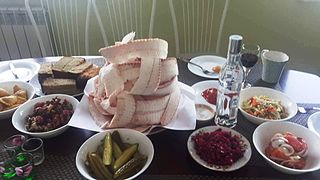 W
WStroganina is a dish of the indigenous people of northern Arctic Siberia consisting of raw, thin, long-sliced frozen fish. Around Lake Baikal, the dish is referred to as raskolotka. Traditional stroganina is made with freshwater whitefish salmonids found in the Siberian Arctic waters such as nelma, muksun, chir, and omul. Rarely, it is made with sturgeon. This dish is popular with native Siberians, and is present in Yakutian cuisine, Eskimo cuisine, Komi cuisine and Yamal cuisine. It is often paired with vodka.
 W
WSundubu-jjigae or soft tofu stew is a jjigae in Korean cuisine. The dish is made with freshly curdled soft tofu, vegetables, sometimes mushrooms, onion, optional seafood, optional meat, and gochujang or gochu garu. The dish is assembled and cooked directly in the serving vessel, which is traditionally made of thick, robust porcelain, but can also be ground out of solid stone. A raw egg can be put in the jjigae just before serving, and the dish is delivered while bubbling vigorously. It is typically eaten with a bowl of cooked white rice and several banchan.
 W
WSurf and turf or surf 'n' turf is a main course combining seafood and red meat. A typical seafood component would be lobster, prawns, shrimp, squid or scallops, any of which could be steamed, grilled or breaded and fried. The meat is typically beef steak, although others may be used. One standard combination is lobster tail and filet mignon.
 W
WSushi is a traditional Japanese dish of prepared vinegared rice , usually with some sugar and salt, accompanying a variety of ingredients , such as seafood, often raw, and vegetables. Styles of sushi and its presentation vary widely, but the one key ingredient is "sushi rice", also referred to as shari (しゃり), or sumeshi (酢飯).
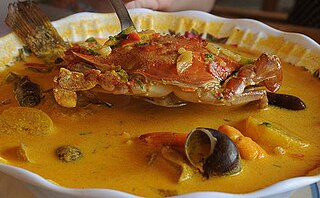 W
WTapado is a seafood soup served in Central American countries such as Guatemala and Honduras. It uses coconut milk and seafood as well as plantains. Within these countries, tapado is associated with the Garifuna community.
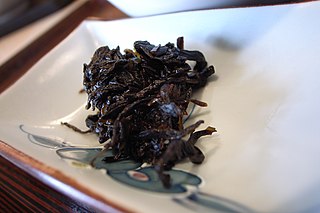 W
WTsukudani (佃煮) is small seafood, meat or seaweed that has been simmered in soy sauce and mirin. High osmotic pressure preserves the ingredients. Its name originates from Tsukudajima, the island where it was first made in the Edo period. Many kinds of tsukudani are sold. Traditionally made tsukudani is preservable and has been favored as a storable side dish in Japanese kitchens since the Edo period.
 W
WUlmyeon is a noodles, vegetables, egg, and seafood in a chowder-like broth that is thickened with cornstarch. It is derived from a Chinese dish called wēnlŭmiàn (溫滷麵).